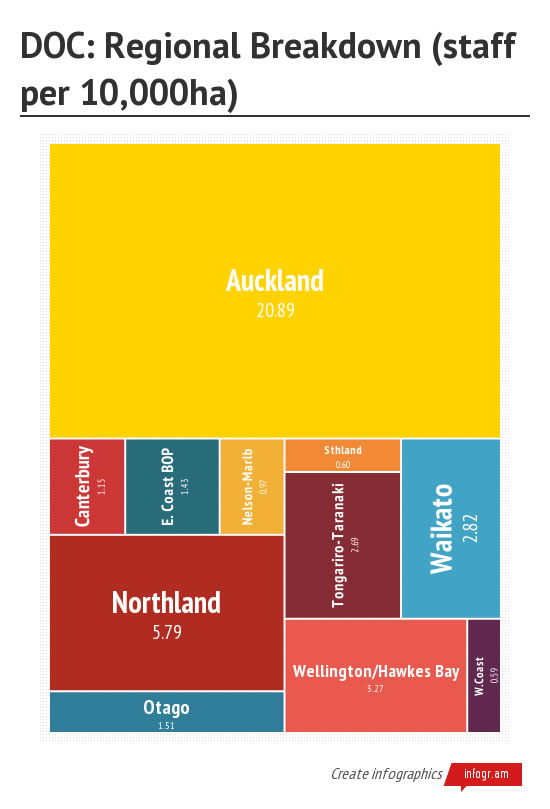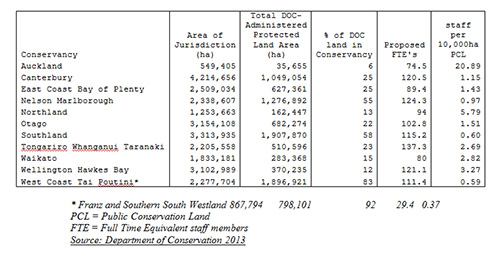DOC Restructuring – a breach of trust with the West Coast
Restructuring the Department of Conservation (DOC) is a breach of trust with the West Coast. It also betrays all the other remote and rural parts of New Zealand that have small populations but large areas of conservation lands.
DOC manages one third of NZ, 8,802,673 hectares, as public conservation land on behalf of all New Zealanders. In doing this it honours commitments made by generations past who created a National Parks and Reserves network that remains the envy of the world. Protection of conservation land also upholds the promise we make to our children. We are the guardians for future generations of the unique native plants, native animals and natural landscapes that make NZ special.
DOC also upholds a special relationship between the people of NZ and the West Coast. 83% of the West Coast is public protected conservation land, 1.896 million hectares out of the 2.277 million hectare West Coast land area. West Coast conservation land makes up 22% of all conservation land in NZ and roughly one third of our NZ National Park land area.
Conservation protection has occurred in distinct stages over the last 120 years and each stage has been actively debated. The resulting protection decision was always accompanied by a Government commitment to adequately manage those protected lands both for conservation and as key areas for recreation and tourism. Each parcel of protected land has been fought for – on the West coast it started with Arthur’s Pass National Park (1929) with our most recent additions being Kahurangi National Park (1996) and Timberlands native forest (2002).
The social contract between the NZ government and the West Coast was that in exchange for forest protection, central government would fund proper management of these areas for conservation and recreation. In these forests visitor developments of walks, tracks, roads, information panels, visitor centres and public toilets have all underpinned the burgeoning West Coast tourism industry.
Until now these promises have generally been honoured. There are pest control programmes that have ensured that nearly half of the protected West Coast forests managed by DOC receive extensive and regular pest control. This is a higher proportion than in any other NZ region.
There are special conservation programmes to rescue and restore Haast brown kiwi/tokoeka, Okarito brown kiwi/rowi, whio/blue duck, mohua/yellowhead, giant landsnails and wetland habitat for whitebait. In the last 30 years there has been a blossoming of West Coast recreation and tourism facilities and tourism concessions that now underpin our tourism industry.
Where I live in southern South Westland, DOC visitor walks at Ship Creek, Hapuka Estuary, Jacksons Bay and Monro Beach have become “must dos” on most visitor agendas in a way that this community only dreamed about when these were first built 22 years ago.
Despite the promise that no frontline conservation jobs would be lost, under DOC’s 2013 restructuring plans, 18% of the frontline jobs on the Coast are being disestablished. This is a higher proportion that any other New Zealand region except for East Coast- Bay of Plenty (21%).
Three DOC staff look after the walks, campgrounds, parking areas and clean the toilets over a 120km stretch of highway from Lake Paringa to Jacksons Bay and inland nearly to the Haast Pass. These three3 jobs will reduced to two2. The programme manager coordinating NZ’s most extensive & effective pest control programme and the endangered species programme for South Westland has lost this job. The Area Manager for the 798,101ha of South Westland conservation land south of the Waitaha River, 10% of NZ’s total area of conservation land, has lost his job. He presently coordinates activities as diverse as access planning for both glaciers, the operation of two major visitor centres (Franz and Haast), community engagement, concessions and DOC’s back country huts and recreational hunting.
Conservation jobs are vital for the remote and rural parts of NZ. Losses of DOC permanent positions will have a huge impact on these communities, services and small schools. Ironically in the urban centres, where there is alternative employment and local communities are not so dependent on conservation jobs, the DOC cuts will have less impact..
DOC job cuts are blamed on a general tightening of economic circumstances and the need to save money. That might be acceptable if it wasn’t for the fact that while DOC is required to save $9 million this year (2012/2013), the Government has just announced an additional $158 million of special funding for NZ tourism promotion over the next 4 years. Encouraging more people to come to NZ will inevitably place more pressure on vital but mundane facilities like the Knights Point and Ship Creek toilets where DOC restructuring is reducing maintenance jobs by a third.
However it isn’t just belt tightening that is motivating the DG of DOC Al Morrison in his restructure. He plans to create many new, largely city based, jobs in DOC’s “Partnership” division. Morrison believes that these DOC staff will motivate community volunteers to do work that DOC presently does and more besides.
Moreover he thinks there is a great pool of sponsorship dollars looking for a home in conservation projects. Some hope! Many of DOC’s corporate sponsors are State Owned Enterprises. These publicly owned companies may have more money that they’d like to put into conservation. Meridian has just advised me that our electricity day commercial rate will shortly rise to 30c/Kwh (unit). This is double what we paid 10 years ago. It is 3 times what the average American pays for their electricity. Am I alone in wishing that Meridian and all the other power companies stuck to their knitting and delivered electricity at the lowest possible cost to the embattled NZ consumer and let DOC focus on the conservation job Parliament requires it to do on our behalf? Other DOC sponsors such as Solid Energy and Rio Tinto (Comalco) have withdrawn or are drastically reducing their DOC sponsorships because their businesses faced headwinds.
Are we prepared to accept a major reduction in our West Coast visitor facilities? Are we prepared to accept a new era of ecological degradation in our West Coast protected areas as the stoats, rats and possums recolonise forests where effective DOC programmes had reduced pests to low levels?. Are we prepared to accept the reduction of West Coast icons such as the Haast and Okarito brown kiwis, whio, rata trees and giant landsnails?
Senior DOC staff have proposed an alternative approach that does not divide DOC into 2 divisions nor result in major job losses in rural areas. This retains the present structure of DOC but amalgamates a number of DOC Area Offices into a single office. It meets the financial goals set for the Department. For the last 2 years, this model has been operational in South Westland across 10% of DOC’s total lands.. The close coordination of Glacier Access signage and planning, expansion of Lake Matheson carpark, renewal of Ship Creek walks, coordination of the kiwi rescue programmes and ecosystem pest programmes all point to the effectiveness of this model. In addition there are active conservation partnerships with community, school and tourism businesses..
. Despite fears about recriminations, 1050 staff submissions were received by DOC, the majority expressing outrage over the proposal and describing it as unworkable. These DOC staff understand that in remote and rural NZ, so much of conservation is already about partnerships and relationships. Here you are judged far more by your actions than by your words. DOC loses credibility if the Knights Point toilets are filthy, if there are rat explosions in the bush, if the whitebait regulations are not being enforced and if the tracks are overgrown.
We treasure our conservation lands and native plants and animals. We understand that these places need active management and that this management cannot be done from Wellington. Volunteers and corporate sponsorship can help but the core work still needs to be done by skilled field staff. Conservation Minister Nick Smith needs to heed this message.
Gerry McSweeney first lived on the West Coast in 1978. Since 1989 he and his wife Anne Saunders established and still own and operate Lake Moeraki Wilderness Lodge. They live at Lake Moeraki near Haast. They also operate a Wilderness Lodge and farm at Arthur’s Pass. South Westland. Gerry is a Conservation Ambassador for Forest and Bird. In 1986, while working for Forest and Bird, Gerry was a member of the Department of Conservation Establishment Unit but he has never been employed by DOC


